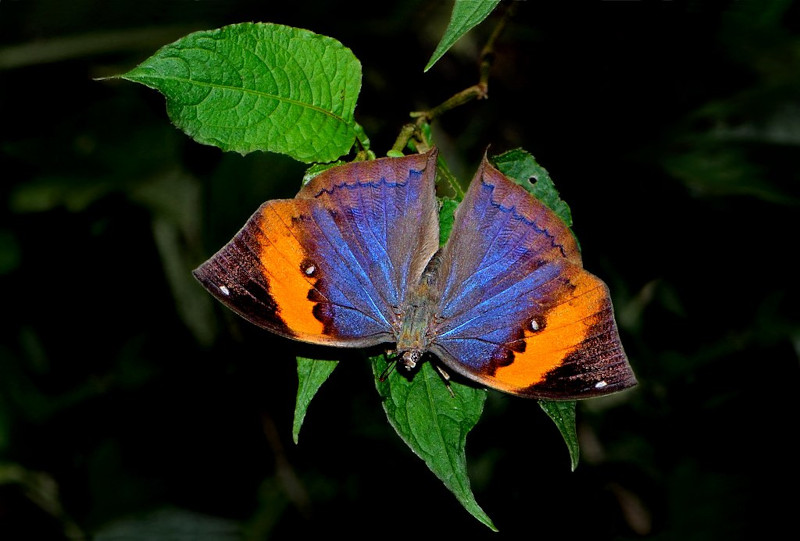Orange Oakleaf Facts
- This magnificent Lepidoptera most frequently goes by the unusual, but descriptive and somewhat informative, common name of the Orange Oakleaf. The beautiful insect also possesses several other general names, though, in various parts of its range.
- These include such terms as the dead leaf and the Indian oakleaf. Professionals, like researchers, typically refer to it by its formal scientific name. That’s the less colorful term of the Kallima inachus. But, by either name, it’s a beautiful species.
- It received its technical name due to the work of the respected French zoologist, Louis Michel François Doyère. This noted researcher made the first formal ackowledgement of it as a separate and distinct species. This noteworthy action occurred in 1840.
- Fortunately, the stunning butterfly appears to currently be maintaining a population base that’s both stable and sufficient. This fortunate trend also seems to hold true throughout the entirety of the known native range of the breathtaking invertebrate.
- This sitution further distinguishes it from many of its relatives, unfortunately for them. Due to that situation, however, the IUCN presently has no listing for the species. If it held a status with them, it would appear on the organization’s updated Red List.
- The marvelous Orange Oakleaf does face some potential threats to its existence. That’s because, like nuerous creatures, habitat loss presents a potential threat. Most likely, though, its greatest threat comes from the effects of ongoing climate change.
Related Articles



Orange Oakleaf Physical Description
The vusually stunning Orange Oakleaf clearly garners attention and admiration from those fortunate enough to encounter it. The dazzling Arthropod further does so for several reasons. This alone distinguishes it from many of its countless relatives globally.
For starters, part of that’s due to the fact that it ranks as comparatively large for a butterfly. It also, much like many other Lepidopotera, displays a moderate degree of the physiological characteristic of sexual dimorphism. In its case though, it’s not in size.
Mature individuals of both genders therefore remain virtually identical in overall average sizes. This often varies from region to region, however. That’s typically due to various environmental factors. A typical wingspan nevertheless ranges from 3.3 – 4.3 in (8.5 – 11 cm).
It’s in general appearance, though, that the gender-based difference manifests itself, though in only minor ways. The upper side of the hindwing primarily presents as a light blue shade. It also displays mulitple light colored lines, running from front to back.
The upper side of the forewings, however, present a strikingly different pattern. These, in fact, manifest a pattern of three different sections. The outer area shows deep black, with a small white spot near the tip. The middle, though, shows orange, and the base light blue.
Yet it’s the under side of both wings that truly set the Orange Oakleaf apart. That’s due to the extraordinary degree of camouflage the invertebrate has evolved. This part of the wings present shades of dark and light brown, with a texture resembling a dried leaf.
- Kingdom: Animalia
- Phylum: Arthropoda
- Class: Insecta
- Order: Lepidoptera
- Family: Nymphalidae
- Genus: Kallima
- Species: K. inachus
Orange Oakleaf Distribution, Habitat, and Ecology
For those of us who appreciate Nature, it’s pleasant to know that the remarkable Orange Oakleaf inhabits a moderately extensive part of the globe. That’s due to the fact that this marvel of evolution evolved as native to certain sections of the continent of Asia.
Generally speaking, this native zone of habitation extends roughly from Japan to India. Within that zone, though, it naturally appears ins some areas more than others. The majority of specimens therefore live in countries that include Nepal, India, China, and Taiwan.
Across the regions in which it appears, however, it displays a fairly impressive versatility. That’s due to the fact that it appears across a wide range of altitudes. Some concentrations appear at or near sea level. Others, meanwhile, live as high as 8,000 ft (2,400 m).
In all of these habitats, though, the invertebrate displays decided preferences for the type of environment it calls home. That’s because the vast majority of individuals live in dense forests. Most further appear along small streams, and amongst the dense undergrowth.
Like many of the species in its Family, the beautiful Orange Oakleaf evolved as frugivorous in nature. It therefore possesses a strong preference for certain sources of food. These sources principally consist of the sap from local trees, and various overly ripe fruit.
On the other hand, its own predators include a wide array of creatures. This list mainly includes local species of ants, spiders, birds, and wasps, though. In defense, it developed powerful wings, making it a strong flyer. Camouflage remains its main defense, however.
Species Sharing Its Range



Check out our other articles on 5 Appalachian Mountains Species, Honey Badger, Victoria Falls, Zebra Shark, Indigo Milk Cap, Indian Bullfrog, Hemlock Looper, Satanic Leaf-Tailed Gecko












Leave a Reply